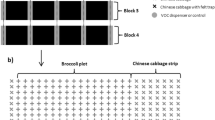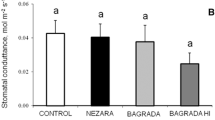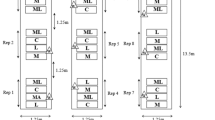Abstract
The use of volatile organic compounds (VOCs) derived from plants to manipulate insect pest behavior can be applied in an integrated pest management strategy (IPM) using a combination of attractive and repulsive stimuli. The “push–pull” strategy was developed on this idea in order to disturb and modify the distribution and abundance of pests to protect crops and reduce the use of agrochemicals. This field experiment investigates, in a “push–pull” context using broccoli as a target crop and Chinese cabbage as a pull component, the stimulo-deterrent effect of five synthetic VOCs (dimethyl disulfide, linalool, geraniol, eucalyptol and citronellol) on the oviposition of the cabbage root fly Delia radicum. With the exception of linalool, all compounds tested had a significant effect in the field and eucalyptol showed the most promising results, reducing oviposition on broccoli by 45 %. Moreover, eucalyptol was the only VOC able to reduce the final infestation of D. radicum, i.e., the number of pupae. The other VOCs reduced oviposition by 20–30 %. No adverse effect of the treatments was found on major parasitoids (Trybliographa rapae and Aleochara bipustulata) and potential predators of D. radicum. This study highlights the potential of VOCs as deterrent stimuli against agricultural pests in the field.


Similar content being viewed by others
References
Bates D, Machler M, Bolker BM, Walker SC (2015) Fitting linear mixed-effects models using lme4. J Stat Softw 67:1–48. doi:10.18637/jss.v067.i01
Batish DR, Singh HP, Kohli SK, Kaur S (2008) Eucalyptus essential oil as a natural pesticide. Forest Ecol Manag 256:2166–2174. doi:10.1016/j.foreco.2008.08.008
Baur R, Birch ANE, Hopkins RJ, Griffiths DW, Simmonds MSJ, Stadler E (1996) Oviposition and chemosensory stimulation of the root flies Delia radicum and D. floralis in response to plants and leaf surface extracts from resistant and susceptible Brassica genotypes. Entomol Exp Appl 78:61–75. doi:10.1111/j.1570-7458.1996.tb00765.x
Bekele J, Hassanali A (2001) Blend effects in the toxicity of the essential oil constituents of Ocimum kilimandscharicum and Ocimum kenyense (Labiateae) on two post-harvest insect pests. Phytochemistry 57:385–391. doi:10.1016/S0031-9422(01)00067-X
Benjamini Y, Hochberg Y (1995) Controlling the false discovery rate: a practical and powerful approach to multiple testing. J R Stat Soc B Met 57:289–300. doi:10.2307/2346101
Bennison J, Maulden K, Dewhirst S, Pow E, Slatter P, Wadhams L (2001) Towards the development of a push-pull strategy for improving biological control of western flower thrips on chrysanthemum. In: Proceedings of the 7th international symposium on Thysanoptera, Reggio Calabria, Italy, 2001, pp 199–206
Bligaard J, Meadow R, Nielsen O, Percy-Smith A (1999) Evaluation of felt traps to estimate egg numbers of cabbage root fly, Delia radicum, and turnip root fly, Delia floralis in commercial crops. Entomol Exp Appl 90:141–148. doi:10.1046/j.1570-7458.1999.00432.x
Cabrera JA, Wang D, Gerik JS, Gan J (2014) Spot drip application of dimethyl disulfide as a post-plant treatment for the control of plant parasitic nematodes and soilborne pathogens in grape production. Pest Manag Sci 70:1151–1157. doi:10.1002/ps.3666
Chen F, Ro DK, Petri J, Gershenzon J, Bohlmann J, Pichersky E, Tholl D (2004) Characterization of a root-specific Arabidopsis terpene synthase responsible for the formation of the volatile monoterpene 1,8-cineole. Plant Physiol 135:1956–1966. doi:10.1104/pp.104.044388
Coaker TH, Finch S (1971) The cabbage root fly, Erioischia brassicae (Bouché). Rep Natl Veg Res Stn 1970:23–42
Cook SM, Khan ZR, Pickett JA (2007) The use of push–pull strategies in integrated pest management. Annu Rev Entomol 52:375–400. doi:10.1146/annurev.ento.52.110405.091407
Costa AV, Pinheiro PF, de Queiroz VT, Rondelli VM, Marins AK, Valbon WR, Pratissoli D (2015) Chemical composition of essential oil from Eucalyptus citriodora leaves and insecticidal activity against Myzus persicae and Frankliniella schultzei. J Essent Oil Bear Plants 18:374–381. doi:10.1080/0972060x.2014.1001200
Crespo E, Hordijk CA, de Graaf RM, Samudrala D, Cristescu SM, Harren FJ, van Dam NM (2012) On-line detection of root-induced volatiles in Brassica nigra plants infested with Delia radicum L. root fly larvae. Phytochemistry 84:68–77. doi:10.1016/j.phytochem.2012.08.013
den Ouden H, Visser JH, Alkema DPW, de Vlieger JJ, Derks PSM (1993) Experiments with volatile substances in slow release formulations causing repellency for oviposition by the cabbage root fly, Phorbia brassicae Bché. (Dipt., Anthomyiidae). J Appl Entomol 115:307–312. doi:10.1111/j.1439-0418.1993.tb00395.x
den Ouden H, Bulsink A, Theunissen J (1996) Compounds repellent to Delia radicum (L.) (Dipt., Anthomyiidae). J Appl Entomol 120:427–432. doi:10.1111/j.1439-0418.1996.tb01631.x
Diaz-Montano J, Trumble JT (2013) Behavioral responses of the potato Psyllid (Hemiptera: Triozidae) to volatiles from dimethyl disulfide and plant essential oils. J Insect Behav 26:336–351. doi:10.1007/s10905-012-9350-8
Doane JF, Chapman RK (1964) Development of the cabbage maggot Hylemyia brassicae (Bouché) on aseptic and decaying rutabaga tissue. Entomol Exp Appl 7:115–119. doi:10.1111/j.1570-7458.1964.tb02428.x
Dugravot S, Grolleau F, Macherel D, Rochetaing A, Hue B, Stankiewicz M, Huignard J, Lapied B (2003) Dimethyl disulfide exerts insecticidal neurotoxicity through mitochondrial dysfunction and activation of insect K(ATP) channels. J Neurophysiol 90:259–270. doi:10.1152/jn.01096.2002
Essawy AE, Gaaboub IA, Abdel-Moneim AM, El-Sayed SA (2015) Neuropathological effect of dimethyl disulfide on neurons of the desert locust Schistocerca gregaria. Toxicol Ind Health 31:422–428. doi:10.1177/0748233713475525
Ferry A (2007) Écologie chimique appliquée à la lutte contre Delia radicum, la mouche du chou. PhD in Biology, Université de Rennes 1
Ferry A, Dugravot S, Delattre T, Christides JP, Auger J, Bagneres AG, Poinsot D, Cortesero AM (2007) Identification of a widespread monomolecular odor differentially attractive to several Delia radicum ground-dwelling predators in the field. J Chem Ecol 33:2064–2077. doi:10.1007/s10886-007-9373-3
Ferry A, Le Tron S, Dugravot S, Cortesero AM (2009) Field evaluation of the combined deterrent and attractive effects of dimethyl disulfide on Delia radicum and its natural enemies. Bio Control 49:219–226. doi:10.1016/j.biocontrol.2009.01.013
Finch S (1978) Volatile plant-chemicals and their effect on host plant finding by the cabbage root fly (Delia brassicae). Entomol Exp Appl 24:350–359. doi:10.1111/j.1570-7458.1978.tb02793.x
Fournet S, Stapel JO, Kacem N, Nenon JP, Brunel E (2000) Life history comparison between two competitive Aleochara species in the cabbage root fly, Delia radicum: implications for their use in biological control. Entomol Exp Appl 96:205–211. doi:10.1046/j.1570-7458.2000.00698.x
Furtado R, Baptista J, Lima E, Paiva L, Barroso JG, Rosa JS, Oliveira L (2014) Chemical composition and biological activities of Laurus essential oils from different Macaronesian Islands. Biochem Syst Ecol 55:333–341. doi:10.1016/j.bse.2014.04.004
Hawkes C (1972) The diurnal periodicity and cycle of behaviour of the adult cabbage root fly (Erioischia brassicae). Ann Appl Biol 70:109–118. doi:10.1111/j.1744-7348.1972.tb04695.x
Hawkes C (1975) Physiological condition of adult cabbage root fly (Erioischia brassicae (Bouché)) attracted to host-plants. J Appl Ecol 12:497–506. doi:10.2307/2402170
Heil M (2008) Indirect defence via tritrophic interactions. New Phytol 178:41–61. doi:10.1111/j.1469-8137.2007.02330.x
Huang M, Sanchez-Moreiras AM, Abel C, Sohrabi R, Lee S, Gershenzon J, Tholl D (2012) The major volatile organic compound emitted from Arabidopsis thaliana flowers, the sesquiterpene (E)-beta-caryophyllene, is a defense against a bacterial pathogen. New Phytol 193:997–1008. doi:10.1111/j.1469-8137.2011.04001.x
Hurter J, Ramp T, Patrian B, Stadler E, Roessingh P, Baur R, de Jong R, Nielsen JK, Winkler T, Richter WJ, Muller D, Ernst B (1999) Oviposition stimulants for the cabbage root fly: isolation from cabbage leaves. Phytochemistry 51:377–382. doi:10.1016/s0031-9422(99)00062-x
Ibanez S, Dotterl S, Anstett MC, Baudino S, Caissard JC, Gallet C, Despres L (2010) The role of volatile organic compounds, morphology and pigments of globeflowers in the attraction of their specific pollinating flies. New Phytol 188:451–463. doi:10.1111/j.1469-8137.2010.03317.x
Karemu CK, Ndung’u MW, Githua M (2013) Repellent effects of essential oils from selected eucalyptus species and their major constituents against Sitophilus zeamais (Coleoptera: Curculionidae). Int J Trop Insect Sci 33:188–194. doi:10.1017/s1742758413000179
Kaufman PE, Mann RS, Butler JF (2010) Evaluation of semiochemical toxicity to Aedes aegypti, Ae. albopictus and Anopheles quadrimaculatus (Diptera: Culicidae). Pest Manag Sci 66:497–504. doi:10.1002/ps.1899
Kergunteuil A, Dugravot S, Mortreuil A, Le Ralec A, Cortesero AM (2012) Selecting volatiles to protect brassicaceous crops against the cabbage root fly, Delia radicum. Entomol Exp Appl 144:69–77. doi:10.1111/j.1570-7458.2012.01257.x
Kergunteuil A, Dugravot S, Danner H, van Dam NM, Cortesero AM (2015) Characterizing volatiles and attractiveness of five Brassicaceous plants with potential for a ‘push–pull’ strategy toward the cabbage root fly, Delia radicum. J Chem Ecol 41:330–339. doi:10.1007/s10886-015-0575-9
Khan ZR, Pickett JA, van den Berg J, Wadhams LJ, Woodcock CM (2000) Exploiting chemical ecology and species diversity: stem borer and striga control for maize and sorghum in Africa. Pest Manag Sci 56:957–962. doi:10.1002/1526-4998(200011)56:11<957:aid-ps236>3.0.co;2-t
Khan ZR, Midega CAO, Amudavi DM, Hassanali A, Pickett JA (2008) On-farm evaluation of the ‘push–pull’ technology for the control of stemborers and striga weed on maize in western Kenya. Field Crop Res 106:224–233. doi:10.1016/j.fcr.2007.12.002
King KM, Forbes AR (1954) Control of root maggots in Rutabagas. J Econ Entomol 47:607–615. doi:10.1093/jee/47.4.607
Klocke JA, Darlington MV, Balandrin MF (1987) 1,8-Cineole (Eucalyptol), a mosquito feeding and ovipositional repellent from volatile oil of Hemizonia fitchii (Asteraceae). J Chem Ecol 13:2131–2141. doi:10.1007/BF01012562
Knudsen JT, Eriksson R, Gershenzon J, Ståhl B (2006) Diversity and distribution of floral scent. Bot Rev 72:1–120. doi:10.1663/0006-8101(2006)72[1:dadofs]2.0.co;2
Koul O, Singh R, Kaur B, Kanda D (2013) Comparative study on the behavioral response and acute toxicity of some essential oil compounds and their binary mixtures to larvae of Helicoverpa armigera, Spodoptera litura and Chilo partellus. Ind Crop Prod 49:428–436. doi:10.1016/j.indcrop.2013.05.032
Kuhnle A, Muller C (2011) Relevance of visual and olfactory cues for host location in the mustard leaf beetle Phaedon cochleariae. Physiol Entomol 36:68–76. doi:10.1111/j.1365-3032.2010.00763.x
Lee S, Tsao R, Peterson C, Coats JR (1997) Insecticidal activity of monoterpenoids to western corn rootworm (Coleoptera: Chrysomelidae), twospotted spider mite (Acari: Tetranychidae), and house fly (Diptera: Muscidae). J Econ Entomol 90:883–892. doi:10.1093/jee/90.4.883
Lenth RV (2014) lsmeans: least-squares means. http://CRAN.R-project.org/package=lsmeans. Accessed November 2015
Lewis JA, Papavizas GC (1970) Evolution of volatile sulfur-containing compounds from decomposition of crucifers in soil. Soil Biol Biochem 2:239–246. doi:10.1016/0038-0717(70)90030-1
Li SQ, Fang YL, Zhang ZN (2007) Effects of volatiles of non-host plants and other chemicals on oviposition of Monochamus alternatus (Coleoptera: Cerambycidae). J Pest Sci 80:119–123. doi:10.1007/s10340-006-0158-1
Ma YF, Xiao C (2013) Push-pull effects of three plant secondary metabolites on oviposition of the potato tuber moth, Phthorimaea operculella. J Insect Sci 13:128. doi:10.1673/031.013.12801
Martel JW, Alford AR, Dickens JC (2005) Synthetic host volatiles increase efficacy of trap cropping for management of Colorado potato beetle, Leptinotarsa decemlineata (Say). Agr Forest Entomol 7:79–86. doi:10.1111/j.1461-9555.2005.00248.x
Mbata GN, Payton ME (2013) Effect of monoterpenoids on oviposition and mortality of Callosobruchus maculatus (F.) (Coleoptera: Bruchidae) under hermetic conditions. J Stored Prod Res 53:43–47. doi:10.1016/j.jspr.2013.02.001
McEwan M, Macfarlane Smith WH (1998) Identification of volatile organic compounds emitted in the field by oilseed rape (Brassica napus ssp. oleifera) over the growing season. Clin Exp Allergy 28:332–338. doi:10.1046/j.1365-2222.1998.00234.x
Meats A, Beattie A, Ullah F, Bingham S (2012) To push, pull or push-pull? A behavioural strategy for protecting small tomato plots from tephritid fruit flies. Crop Prot 36:1–6. doi:10.1016/j.cropro.2012.02.002
Miller JR, Cowles RS (1990) Stimulo-deterrent diversion: a concept and its possible application to onion maggot control. J Chem Ecol 16:3197–3212. doi:10.1007/bf00979619
Mitchell B (1963) Ecology of two carabid beetles, Bembidion lampros (Herbst) and Trechus quadristriatus (Schrank). J Anim Ecol 32:377–392. doi:10.2307/2599
Montefuscoli AR, Werdin Gonzalez JO, Palma SD, Ferrero AA, Fernandez Band B (2014) Design and development of aqueous nanoformulations for mosquito control. Parasitol Res 113:793–800. doi:10.1007/s00436-013-3710-y
Mukherjee A, Sarkar N, Barik A (2015) Momordica cochinchinensis (Cucurbitaceae) leaf volatiles: semiochemicals for host location by the insect pest, Aulacophora foveicollis (Coleoptera: Chrysomelidae). Chemoecology 25:93–104. doi:10.1007/s00049-014-0179-9
Murungi LK, Kirwa H, Torto B (2013) Differences in essential oil content of berries and leaves of Solanum sarrachoides (Solanaceae) and the effects on oviposition of the tomato spider mite (Tetranychus evansi). Ind Crop Prod 46:73–79. doi:10.1016/j.indcrop.2013.01.022
Neveu N, Grandgirard J, Nenon JP, Cortesero AM (2002) Systemic release of herbivore-induced plant volatiles by turnips infested by concealed root-feeding larvae Delia radicum L. J Chem Ecol 28:1717–1732. doi:10.1023/a:1020500915728
Nilsson U, Eriksson A, Ramert B, Anderson P (2012) Male and female Trybliographa rapae (Hymenoptera: Figitidae) behavioural responses to food plant, infested host plant and combined volatiles. Arthropod-Plant Interact 6:251–258. doi:10.1007/s11829-011-9176-x
ObengOfori D, Reichmuth CH, Bekele J, Hassanali A (1997) Biological activity of 1,8 cineole, a major component of essential oil of Ocimum kenyense (Ayobangira) against stored product beetles. J Appl Entomol 121:237–243. doi:10.1111/j.1439-0418.1997.tb01399.x
Olivero-Verbel J, Nerio LS, Stashenko EE (2010) Bioactivity against Tribolium castaneum Herbst (Coleoptera: Tenebrionidae) of Cymbopogon citratus and Eucalyptus citriodora essential oils grown in Colombia. Pest Manag Sci 66:664–668. doi:10.1002/ps.1927
Pan HS, Lu YH, Wyckhuys KAG (2013) Repellency of dimethyl disulfide to Apolygus lucorum (Meyer-Dur) (Hemiptera: Miridae) under laboratory and field conditions. Crop Prot 50:40–45. doi:10.1016/j.cropro.2013.02.017
Pare PW, Tumlinson JH (1999) Plant volatiles as a defense against insect herbivores. Plant Physiol 121:325–331. doi:10.1104/pp.121.2.325
Prokopy RJ, Collier RH, Finch S (1983) Leaf color used by cabbage root flies to distinguish among host plants. Science 221:190–192. doi:10.1126/science.221.4606.190
Pyke B, Rice M, Sabine B, Zalucki MP (1987) The push-pull strategy—behavioural control of Heliothis. Aust Cotton Grower 4:7–9
R_Core_Team (2013) R: A language and environment for statistical computing. R Foundation for Statistical Computing, Vienna
Reinhard J, Srinivasan MV, Zhang SW (2004) Olfaction: scent-triggered navigation in honeybees. Nature 427:411. doi:10.1038/427411a
Roessingh P, Stadler E, Baur R, Hurter J, Ramp T (1997) Tarsal chemoreceptors and oviposition behaviour of the cabbage root fly (Delia radicum) sensitive to fractions and new compounds of host-leaf surface extracts. Physiol Entomol 22:140–148. doi:10.1111/j.1365-3032.1997.tb01151.x
Rousse P, Fournet S, Porteneuve C, Brunel E (2003) Trap cropping to control Delia radicum populations in cruciferous crops: first results and future applications. Entomol Exp Appl 109:133–138. doi:10.1046/j.1570-7458.2003.00098.x
Samudrala D, Brown PA, Mandon J, Cristescu SM, Harren FJM (2015) Optimization and sensitive detection of sulfur compounds emitted from plants using proton transfer reaction mass spectrometry. Int J Mass Spectrom 386:6–14. doi:10.1016/j.ijms.2015.05.013
Santos JP (2006) Alternatives to chemical control of stored-product insects on small farms in the tropics. In: ABRAPOS (ed) Proceedings of the 9th international working conference on stored-product protection, São Paulo, Brazil, pp 663–674
Saxena KN, Basit A (1982) Inhibition of oviposition by volatiles of certain plants and chemicals in the leafhopper Amrasca devastons (distant). J Chem Ecol 8:329–338. doi:10.1007/BF00987781
Schiestl FP, Roubik DW (2003) Odor compound detection in male euglossine bees. J Chem Ecol 29:253–257
Smart LE, Blight MM, Pickett JA, Pye BJ (1994) Development of field strategies incorporating semiochemicals for the control of the pea and bean weevil, Sitona lineatus L. Crop Prot 13:127–135. doi:10.1016/0261-2194(94)90163-5
Steeghs M, Bais HP, de Gouw J, Goldan P, Kuster W, Northway M, Fall R, Vivanco JM (2004) Proton-transfer-reaction mass spectrometry as a new tool for real time analysis of root-secreted volatile organic compounds in Arabidopsis. Plant Physiol 135:47–58. doi:10.1104/pp.104.038703
Turlings TC, Tumlinson JH, Lewis WJ (1990) Exploitation of herbivore-induced plant odors by host-seeking parasitic wasps. Science 250:1251–1253. doi:10.1126/science.250.4985.1251
Tyler-Julian K, Funderburk J, Frantz G, Mellinger C (2014) Evaluation of a push–pull strategy for the management of Frankliniella bispinosa (Thysanoptera: Thripidae) in bell peppers. Environ Entomol 43:1364–1378. doi:10.1603/EN14048
van Tol R, James DE, de Kogel WJ, Teulon DAJ (2007) Plant odours with potential for a push-pull strategy to control the onion thrips, Thrips tabaci. Entomol Exp Appl 122:69–76. doi:10.1111/j.1570-7458.2006.00489.x
Varis A-L (1967) Studies on the biology of the cabbage root fly (Hylemya brassicae Bouché) and the turnip root fly (Hylemya floralis Fall.). Ann Agric Fenn 6:1–13
Venables WN, Ripley BD (2002) Modern applied statistics with S, 4th edn. Springer, New York. doi:10.1007/978-0-387-21706-2
Vet LEM, Dicke M (1992) Ecology of infochemical use by natural enemies in a tritrophic context. Annu Rev Entomol 37:141–172. doi:10.1146/annurev.en.37.010192.001041
Vuorinen T, Reddy GVP, Nerg AM, Holopainen JK (2004) Monoterpene and herbivore-induced emissions from cabbage plants grown at elevated atmospheric CO2 concentration. Atmos Environ 38:675–682. doi:10.1016/j.atmosenv.2003.10.029
Wilkes A, Wishart G (1953) Studies on parasites of root maggots (Hylemya spp.; Diptera: Anthomyiidae) in the Netherlands in relation to their control in Canada. Eur J Plant Pathol 59:185–188. doi:10.1007/bf01988192
Wishart G, Monteith E (1954) Trybliographa rapae (Westw.) (Hymenoptera: Cynipidae), a parasite of Hylemya spp. (Diptera: Anthomyiidae). Can Entomol 86:145–154. doi:10.4039/Ent86145-4
Wynde FJ, Port GR (2012) The use of olfactory and visual cues in host choice by the capsid bugs Lygus rugulipennis Poppius and Liocoris tripustulatus fabricius. PLoS ONE 7:e46448. doi:10.1371/journal.pone.0046448
Yan HX, Zeng JW, Zhong GY (2015) The push–pull strategy for citrus psyllid control. Pest Manag Sci 71:893–896. doi:10.1002/ps.3915
Zohren E (1968) Laboruntersuchungen zu Massenanzucht, Lebensweise, Eiablage und Eiablageverhalten der Kohlfliege, Chortophila brassicae Bouché (Diptera, Anthomyiidae). J Appl Entomol 62:139–188. doi:10.1111/j.1439-0418.1968.tb04118.x
Acknowledgements
We thank the staff of the ‘Domaine experimental de la Motte’ (INRA Center, Le Rheu, France) and especially Gabriel Nedelec for his advice and help with the field experiment. The authors acknowledge Charline Ridard and Eileen Gazengel for the precious help provided during the monitoring of the experiment.
Funding
This work was financed by the project “PURE” and a grant of the French ministry for research (MESR) to FL.
Author information
Authors and Affiliations
Corresponding author
Ethics declarations
Conflict of interest
Authors declare that they have no conflict of interest.
Ethical approval
All applicable international, national, and/or institutional guidelines for the care and use of animals were followed.
Additional information
Communicated by J. Gross.
Rights and permissions
About this article
Cite this article
Lamy, F.C., Poinsot, D., Cortesero, AM. et al. Artificially applied plant volatile organic compounds modify the behavior of a pest with no adverse effect on its natural enemies in the field. J Pest Sci 90, 611–621 (2017). https://doi.org/10.1007/s10340-016-0792-1
Received:
Revised:
Accepted:
Published:
Issue Date:
DOI: https://doi.org/10.1007/s10340-016-0792-1




